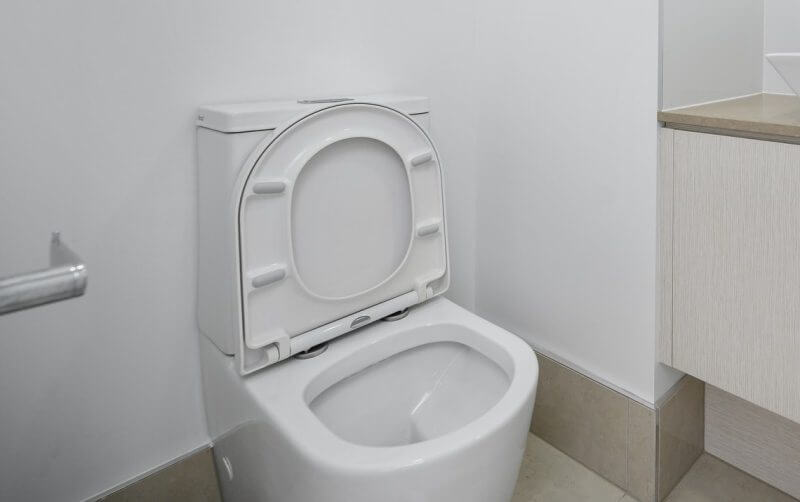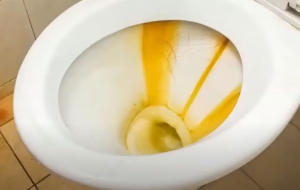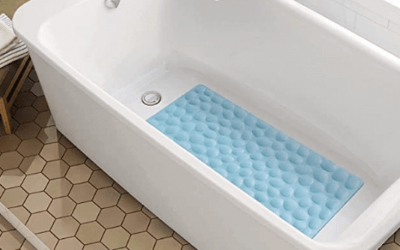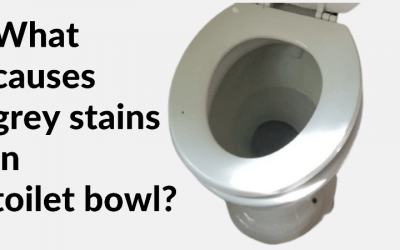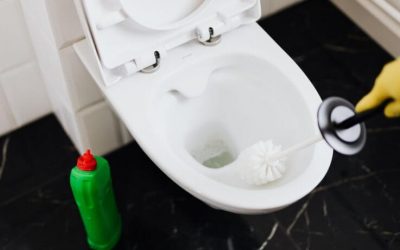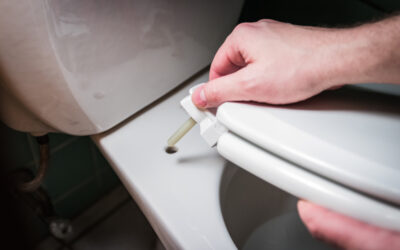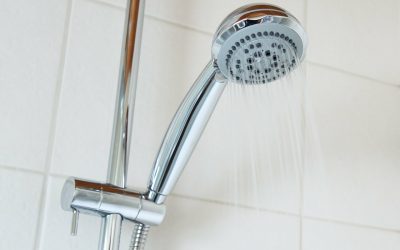If you’re like me, you can’t stand seeing dirty or stained toilet seats. But what causes yellow stains on toilet seat?
A stained toilet is embarrassing and you can’t blame people for thinking that you do not take time to clean up after yourself.
However, there is no need for concern because there are many reasons why your toilet seat might have yellow stains and some of these are beyond your control.
Keep reading this article if you want to know more about how these pesky stains happen and how best to remove them from your own toilet seat at home.
What causes yellow stains on toilet seat or lid?
There are several causes of the yellow stains on your toilet seat. Here are some of the causes.
1. Urine and fecal matter stains
The yellow stains on your toilet seat are most likely caused by urine.
When urine comes into contact with water, the ammonia salts break down into ammonium hydroxide. This compound breaks down organic matter like bacteria or fungi on the toilet’s seat, lid, and bowl.
When this happens over time, your toilet seat may develop yellow stains from high concentrations of uric acid (a component of urine) breaking down to form crystals.
These crystals then react with other substances present in the environment like iron oxide found in rust-colored hard water.
Such stains are extremely difficult to get rid of so you may need the right products and a little elbow grease.
2. Hard water stains
Do you worry about hard water stains on surfaces around your house? Hard water stains on toilet seats are a common problem for many homeowners.
They occur as a result of a build-up in calcium and other minerals that can accumulate over time on the toilet seat or bowl.
Also, they could arise from mineral deposits left behind by your city’s tap water treatment process.
Hard water stains on the toilet seats can be tough to remove. However, with the right products and techniques, it is possible to get rid of them.
For instance, a mixture of hydrogen peroxide and baking soda is guaranteed to remove those pesky stains once and for all.
3. Use of bleach
If your toilet seat is turning yellow, the bleach you’re using may be to blame.
Bleach is an excellent disinfectant but it might discolor your plastic toilet seat, especially when used in an undiluted state.
It turns the toilet seat yellow because of a chemical reaction between the bleach and the plastic on the toilet seat.
You can opt to try a different brand or dilute the bleach more before using it on the toilet.
See also: How to remove grey stains from toilet bowl
How to clean yellow toilet seat stains
I’m sure you’re all wondering how to get rid of those pesky yellow stains that seem to be sticking around.
Here’s the thing, it doesn’t matter what kind of toilet seat cover you have; the stains will persist if something is not done quickly.
In order to remove them effectively, you will need to identify the cause of the stains on your toilet seat and use the right product. Here are some of our favorite tips that will help you get rid of those yellow rings in no time at all.
(i) How to remove urine and hard water stains from toilet seat
-
Using lemon juice and salt
Simply mix lemon juice and salt together in equal parts and then apply the mixture directly onto the stained area of the toilet seat.
Wait for 10 minutes before scrubbing off with warm water and an old toothbrush and rinse off.
-
Baking soda and hydrogen peroxide
Another solution to remove the stains is using baking soda mixed with hydrogen peroxide. Use at least half as much baking soda as there are drops of hydrogen peroxide.
Mix them to form a paste-like consistency that can be applied to the stained toilet seat.
Let it rest for about 10 minutes before cleaning up using either warm water or diluted rubbing alcohol.
-
Use the best product for urine and hard water stains
The best way to get yellow stains off of a toilet seat is by using products that are made specifically for this purpose. Avoid soap, bleach, and other harsh household chemicals because these can damage the finish on your toilet seat and lead to more problems in the long run.
Also, contrary to popular belief, cleaning a stained toilet with bleach will not remove urine or hard water stains.
You need to use a cleaner that has enzymes in it, such as Clorox® ToiletWand®, which is designed for this type of stain removal job. Also, it’s safe to use on most surfaces including porcelain and plastic.
Another enzymatic product that comes highly recommended is The Works Classic Clean Toilet Bowl cleaner. It contains an enzyme cleaner that breaks down organic material while it cleans, hence it is also safer to use at home. In addition, it has odor eliminators so you don’t have to stand the pungent smell from the toilet.
Is it time for a new toilet seat?
Is your toilet seat is just to old and unslighlty to really get clean again? You’ll be happy to know that replacing a toilet seat is quite an easy DIY job. Just be sure to order a new stain resistant toilet seat to avoid the same situation again.
See also: Pros and cons of elongated toilets
FAQ about toilet seat discoloration
Q1. Why is my plastic toilet seat yellowing?
There are several causes of yellowing plastic toilet seats. Some of the most common ones include urine buildup on the underside of the lid, fecal matter left behind after bowel movement, which leads to bacterial growth, and excessive cleaning using abrasive cleaners containing bleach.
Regardless of what’s causing your problem, there are some easy fixes for how to clean yellowed plastic toilet seats. These include using hydrogen peroxide mixed with baking soda or lemon juice and salt. You can also use any toilet cleaning product without bleach.
Q2. Can you clean toilet seat with vinegar?
Vinegar is a great natural cleaner that will break down soap scum and urine stains in the toilet bowl.
You can use any type of vinegar but apple cider vinegar works best because it’s not too harsh. So if you have kids or pets at home, this would be our recommendation.
See also: Does vinegar and baking soda unclog a toilet?
Q3. Why did the toilet seat turn yellow after bleaching?
A toilet seat might turn yellow after bleaching when bleach reacts with other chemicals, urine, or other substances left behind by human waste and create new compounds and cause discoloration.
This is why it is recommended to use a cleaner specifically designed for toilets if you need to clean one on a regular basis. Bleach-free cleaners are more effective at removing stains without reacting with any unwanted substances or causing surface damage.
See also: Will bleach unclog a toilet completely?
Q4. How to remove urine stains from plastic toilet seat
Plastic toilet seats discolor easily and they need delicate products to get rid of the stains because abrasive cleaners may easily scratch and damage them.
One of the most effective products for removing urine stains on plastic toilet seats is rubbing alcohol.
To remove urine stains from a plastic toilet seat, use this process.
- First, wipe up the excess liquid with paper towels or an absorbent cloth and dry it off completely.
- Next, apply the rubbing alcohol to the area in question using a cotton ball or swab until you see no more discoloration.
- Wipe off any remaining residue with another clean cloth before letting your toilet air out for at least half an hour.
- This should take care of most urine stains on plastic seats””though some may require more drastic measures. For those stubborn spots that won’t budge, try scrubbing them away with diluted muriatic acid; be sure to wear gloves and goggles while working on this project.
See also: Best toilet seat material
Conclusion
In this article, we have strived to explain what causes yellow stains on toilet seat. Cleaning the toilet is one of those tasks that no one really likes to do. But with a little knowledge and some simple DIY products, you can make this task easier.
There are many factors that cause yellow stains on your toilet seats such as urine, fecal matter, and hard water.
Luckily, there are plenty of solutions for removing these stubborn stains without using harsh chemicals or toxic ingredients. You can try lemon juice mixed with salt (or baking soda) for hard water stains; hydrogen peroxide paired with an all-natural cleaner for general staining, or even just plain old soap and water for daily maintenance.

